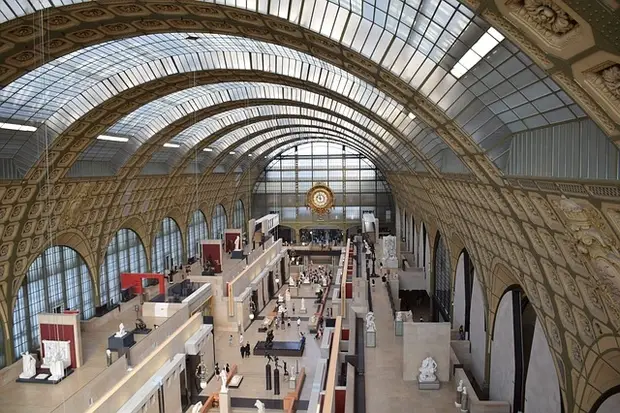Tucked in the west corner of the Tuileries Garden near Place de la Concorde, the Musée de l’Orangerie was built in 1852 as a greenhouse for orange trees. Today, it’s known for Monet’s huge Water Lilies and many Impressionist paintings. Here are 10 reasons why this peaceful museum is worth a visit.
1. See Monet’s Giant Water Lilies Up Close
Voir cette publication sur Instagram
Claude Monet’s gift to France fills two oval rooms with eight panels that are each about 6 ½ feet high and, together, stretch almost the length of a football field—91 meters (298 ft).
Monet asked for skylights so real daylight would glide across the paint from dawn to dusk, making the colors shift just like the pond in his garden.
You can stand only an arm’s length away and trace the thick blue‑green strokes that show ripples, reflections, and tiny lily.
2. Visit One of Paris’s Most Peaceful Museums
Voir cette publication sur Instagram
The Orangerie uses timed tickets and caps the number of people inside at any moment, so galleries stay quiet and benches are almost always free.
Signs at the entrance ask visitors for “silence and serenity,” and the high skylights bathe the white walls in soft natural light—no harsh spotlights, no echoing
3. Skip the Long Lines of Bigger Museums

Booking a time slot means you walk straight to security, while the Louvre often sees visitors wait 45 minutes or more and still struggle with packed rooms.
Recent traveler reviews for the Orangerie praise how “buying ahead helped us skip the line upon arrival,” turning the first five minutes of your visit into art‑time instead of queue‑time.
4. Enjoy a Short, Easy‑to‑Visit Collection
Voir cette publication sur Instagram
The whole permanent collection is just 148 paintings spread over two main levels—Monet’s water‑garden upstairs and the modern masters downstairs.
Guided tours of the entire museum are scheduled for about one hour, which matches how long most people spend on a relaxed, self‑paced visit.
5. Walk Through Monet’s Rooms Built Just for His Paintings
Voir cette publication sur Instagram
Monet collaborated with architect Camille Lefèvre to create two oval halls shaped like an infinity symbol.
The curved walls let each panel flow into the next, while the east‑west layout lines the art up with the path of the sun.
Stepping into the space feels like entering a quiet, watery world that surrounds you on every side.
6. Discover Hidden Gems from Renoir, Cézanne, and Picasso
Voir cette publication sur Instagram
Downstairs you’ll find the Jean Walter–Paul Guillaume collection: 25 paintings by Renoir, 15 by Cézanne, 12 by Picasso, plus works by Matisse, Modigliani, Soutine, and others—148 masterpieces in all.
Because the rooms are compact, you can stand inches from a Renoir portrait, then pivot to a bold Cézanne still life without jostling crowds or losing your spot.
7. Admire Beautiful Art Without Feeling Rushed
Voir cette publication sur Instagram
The Orangerie puts a time‑slot on every ticket, and you can enter any time in the 30‑minute window printed on it.
That limit keeps visitor numbers low, so galleries never feel packed.
Each oval room and most downstairs halls have benches right in the center, so you can sit, sketch, or just stare at the brush‑strokes as long as you like—no one has to squeeze past.
8. Learn the Story Behind Monet’s Famous Series
On November 12, 1918—one day after World War I ended—Monet wrote to Prime‑Minister Georges Clemenceau offering his Water Lily panels as a “monument to peace.”
The formal gift contract was signed in 1922, and the paintings finally went on view in 1927 exactly as Monet planned.
Wall texts (French and English) plus an optional audio guide explain how he painted in his Giverny garden, why he chose oval rooms, and how sunrise panels hang to the east while sunset colors face west.
9. Great for First‑Time Visitors to Impressionist Art
Voir cette publication sur Instagram
Upstairs, Monet’s loose, colorful strokes show what Impressionism is about—capturing light and movement instead of tiny details.
Downstairs, a quick loop of the Walter‑Guillaume rooms lets you compare Renoir’s soft portraits, Cézanne’s blocky fruit, and Picasso’s bold shapes.
A one‑hour English tour called “Masterpieces, Monet to Picasso” runs several times a week, making the style jump out even if you’ve never studied art history.
10. Explore Art History in Just About an Hour
Voir cette publication sur Instagram
Travelers report that a full visit takes roughly 60 minutes—long enough to enjoy everything, short enough to keep kids engaged.
In that hour you see Monet’s 8 giant panels plus 148 modern‑master paintings downstairs, covering Impressionism, Post‑Impressionism, and early Cubism in one neat package.

With a passion for travel and having visited over 50 countries, Dorian is eager to share his favorite spots and expert tips to help you explore Paris and France like a local.




